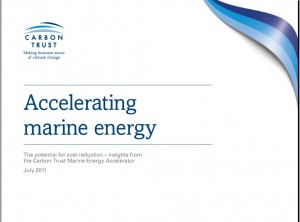Best marine energy sites could be cost competitive with nuclear and onshore wind by 2025
 New in-depth analysis published today by the Carbon Trust shows the UK’s best marine energy sites could generate electricity at costs comparable with nuclear and onshore wind1. With continued and targeted innovation this could be as soon as 2025, once cost reductions from deploying the first gigawatt of energy devices have kicked-in. In the future marine energy could provide a fifth of the UK’s electricity needs.
New in-depth analysis published today by the Carbon Trust shows the UK’s best marine energy sites could generate electricity at costs comparable with nuclear and onshore wind1. With continued and targeted innovation this could be as soon as 2025, once cost reductions from deploying the first gigawatt of energy devices have kicked-in. In the future marine energy could provide a fifth of the UK’s electricity needs.
Through its Marine Energy Accelerator programme, the Carbon Trust has established that the costs for the first wave and tidal energy farms will be around 30-40p/Kwh which is high, relative to today’s more established low carbon technologies, such as offshore wind. These costs are broadly as expected given the early stage of the technologies’ development. Importantly the report concludes how with continued and targeted innovation aggressive reductions in costs can be achieved in the next ten years. The report also quantifies the amount of energy that can realistically be tapped and sets out the actions now needed to set the industry on a path to commercial success.
The analysis shows that wave energy could generate 50 Terra Watt hours (TWh) of electricity per year, equivalent to 13% of the UK’s power needs, and tidal stream 20.6 TWh per year or 5% of UK power needs. Between them wave and tidal stream could generate more electricity than 12 large coal-fired power stations. The fast flowing tides of the deeper areas of the Pentland Firth between the Scottish mainland and the Orkneys alone could ultimately generate almost one third of all tidal stream energy (6 TWh/year) and at an equivalent cost to nuclear and onshore wind.
Technology innovation will be vital to tackle the harsher conditions which are encountered in the deeper areas of the Pentland Firth. With targeted innovation energy generation costs for both wave and tidal stream technologies could reduce to an average of 15 pence per kilowatt hour by 2025 – equivalent to today’s cost of offshore wind energy.
The £3.5m Marine Energy Accelerator has already driven innovation in key areas including device deployment and mooring. Just one of these innovations, developed with Pelamis Wave Power, has projected savings of £15m a year by 2020 through faster installation and connection of the device in rougher weather conditions.
Benj Sykes, Director of Innovations at Carbon Trust, said:
“Marine energy is one of the UK’s most exciting green growth sectors and one where we have a real lead. Wave and tidal stream could provide a fifth of our electricity needs and be a major ‘made in Britain’ success. The key players must now pull together to tackle the next set of challenges and innovate to drive down costs. Our Marine Energy Accelerator, working with key industry players and Government, has shown that savings of tens of millions of pounds are possible.”
Separate Carbon Trust analysis has shown that the UK could capture just under a quarter of the global marine energy market. Equivalent to up to £76bn to the UK economy by 2050, this growing sector could also generate over 68,000 UK jobs.
Download the full report – Accelerating marine energy (CTC797).
Find out more on the Marine Energy Accelerator programme.
[1] Committee on Climate Change Renewable Energy Review, 2011









